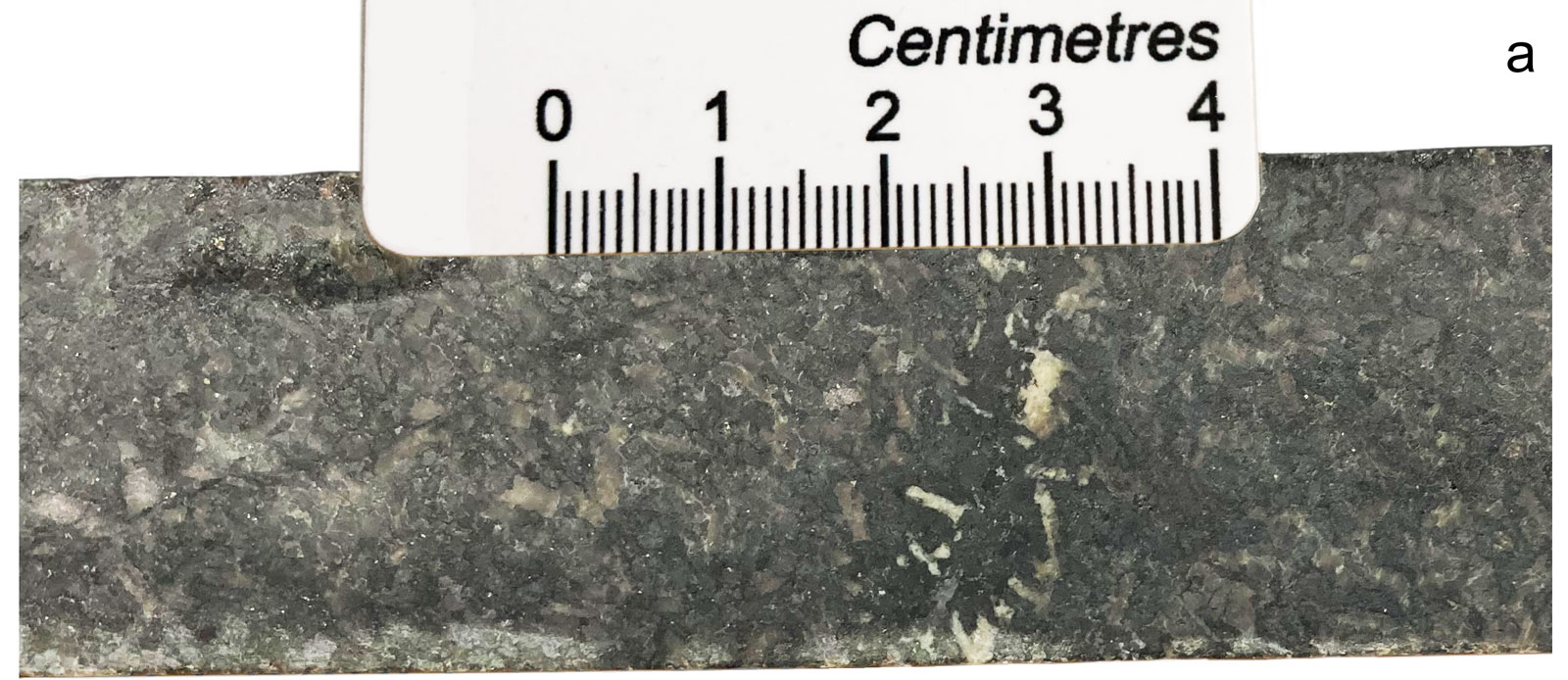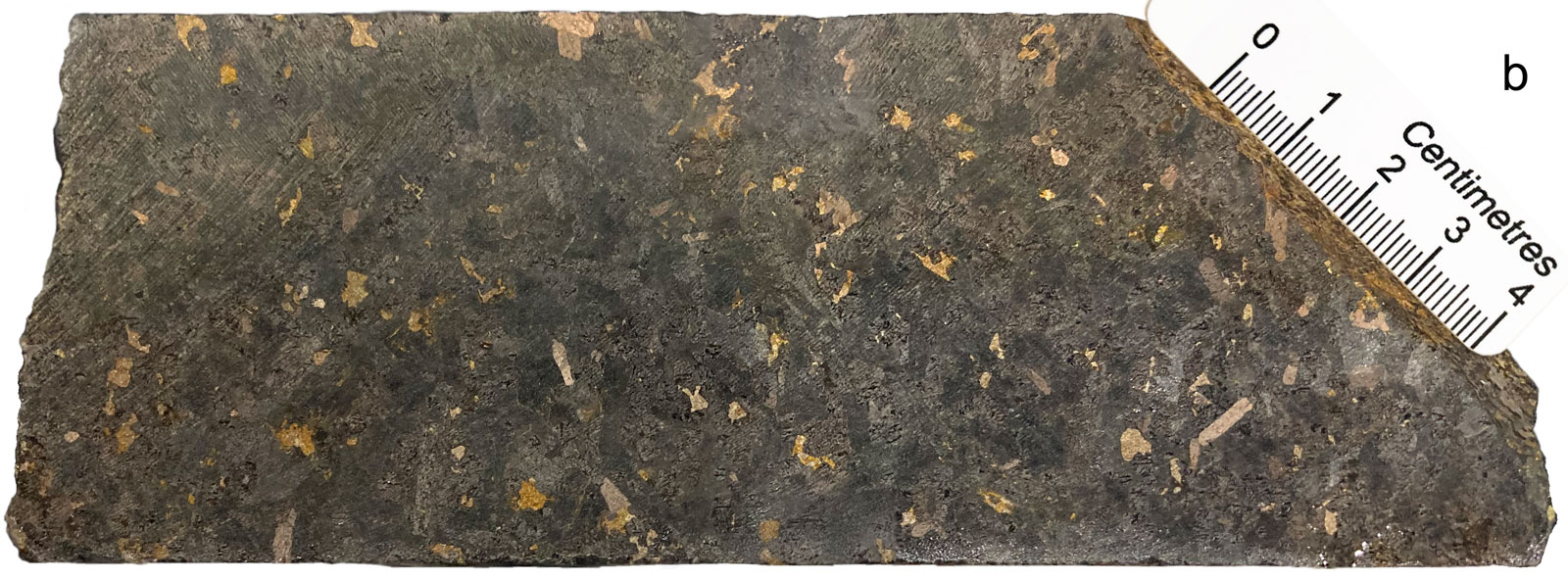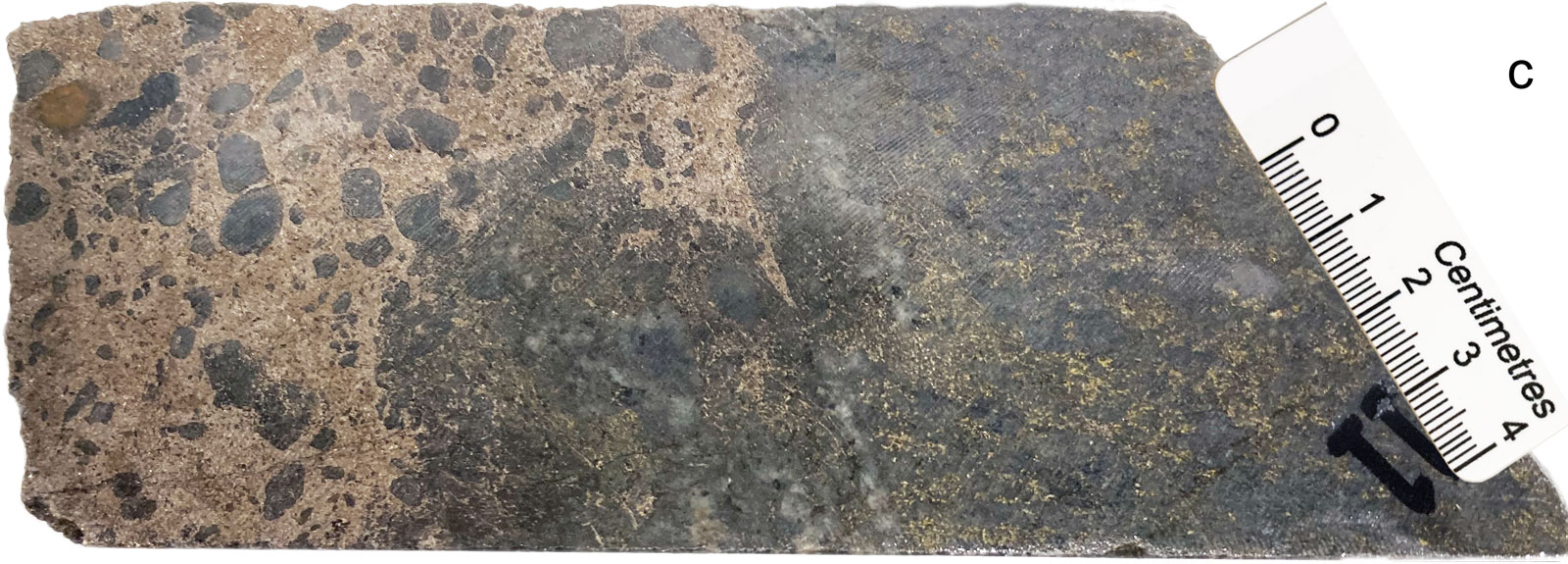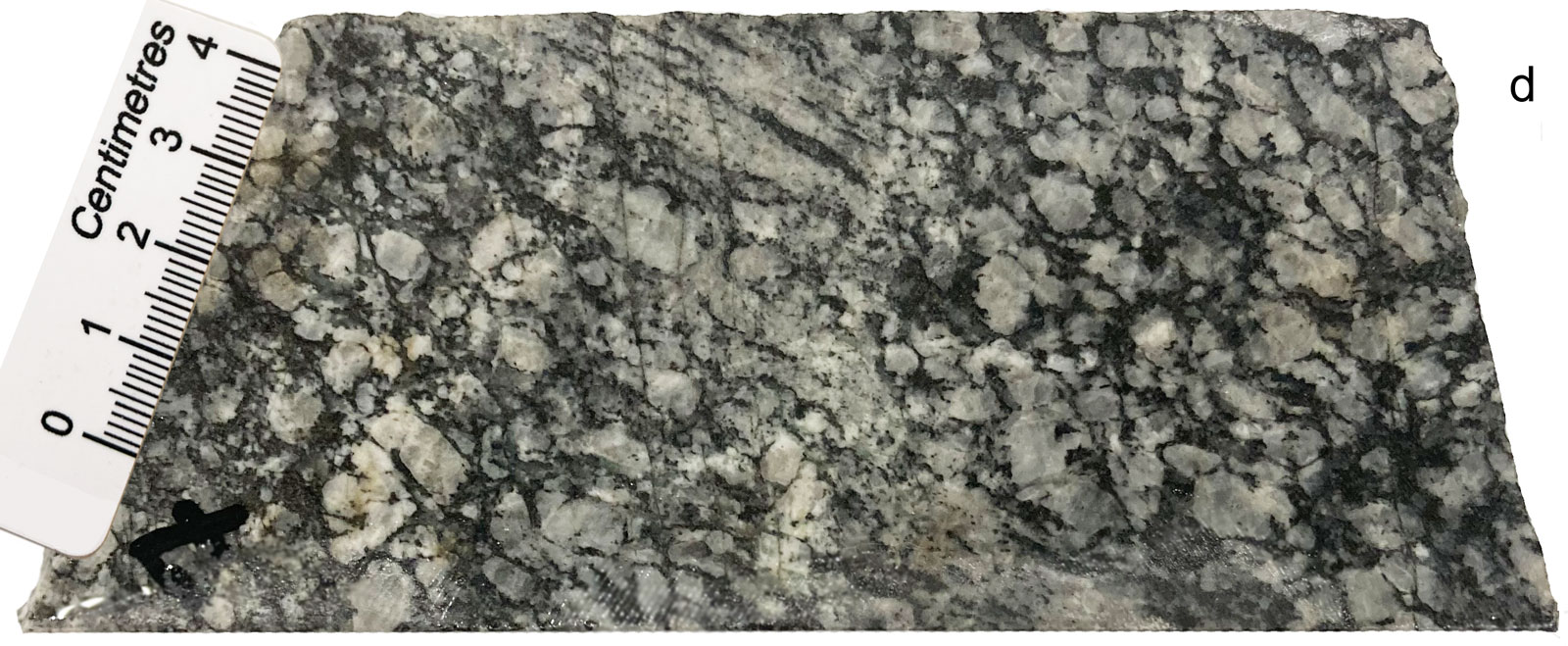|
Nebo, Babel, Succoth |
|
|
South Australia, SA, Australia |
| Main commodities:
Ni Cu PGE PGM
|
|
 |
|
 |
 |
Super Porphyry Cu and Au


|
IOCG Deposits - 70 papers

|
All papers now Open Access.
Available as Full Text for direct download or on request. |
|
 |
The Nebo-Babel Ni-Cu-platinum-group element (PGE) sulphide deposit is located in the West Musgrave Block, eastern Western Australia, approximately 125 km west of the South Australia-Northern Territory-Western Australia junction and 1600 km NE of Perth (#Location: 127° 42'E, 26° 6'S). See Succoth described separately below.
The Musgrave Province is an east-west elongated Mesoproterozoic orogenic belt with a width of some 50 km and 500 km of strike length, bounded by younger continental basin, below which it is more extensive. It comprises a variety of high grade amphibolite to granulite metamorphic grade basement rocks, overprinted by several major tectonic events and intruded by granitic plutons, layered mafic to ultramafic intrusions of the Giles Complex, and by mafic dykes.
The western Musgrave Block contains extensive exposures of the 1078 Ma layered mafic-ultramafic Giles Complex and around 20 major intrusions and numerous smaller bodies of layered cumulates. These bodies display a trend to increasing fractionated composition from east to west, inferring a progressive shallower crustal levels of emplacement. In particular, the Jameson Range layered troctolite-gabbro body, which is some 20 km from the Nebo-Babel deposit, is derived from strongly fractionated melts. At Nebo-Babel, the dominant basement lithology, which is also the the country rock to the mineralised intrusion, is a granitic orthogneiss that has a crystallisation age of of 1147 Ma, and is interpreted to be a member of the Giles, or Pitjantjatjara Supersuite (Seat, et al., 2017).
The protracted 1085 to 1040 Ma Giles Event is also known as the Ngaanyatjarra Rift and is only recognised in the Musgrave Province. It is a large scale event and is interpreted to have been initiated through movement along trans-lithospheric faults. It was also associated with the emplacement of a number of major mafic-ultramafic Giles Complex layered intrusions, voluminous gabbroic and granitic rocks and the widespread extrusion of the Bentley Supergroup bimodal volcanic rocks. It is interpreted to have been the result of compressional crustal thickening, delamination and gravitational collapse of the crustal column, allowing asthenospheric ascent, decompression melting and ponding of that mafic melt at the crust-mantle interface (Aitken et al., 2013). At least ten distinct geochemically and chronological phases are recognised in association with the Giles Complex and denote a complex magmatic history with contemporaneous ductile deformation during the emplacement of smaller intrusive bodies in the late stages of the Giles Event. The subsequent 570 to 530 Ma Petermann Orogeny uplifted and exposed the complex through younger cover and was responsible for the overprinting of widespread mylonitic fabrics within shear zones throughout the Musgrave Province (Seat, et al., 2017).
The Nebo-Babel deposit is hosted by a concentrically tube-like (chonolithic), zoned, olivine-free, gabbronorite intrusion associated with the Giles Complex-layered intrusions in the Warakurna large igneous province. The chonolith hosting Nebo and Babel is interpreted to have been offset by the Jameson Fault, separating the two deposits. An alternative interpretation suggests the fault was a feeder structure along which the two separated bodies were emplaced as separate but co-magmatic bodies. The two deposits have an almost identical morphology and marginal units, but different mineralisation styles, lithostratigraphic units within their cores and degrees of post-magmatic alteration. The chonolith was emplaced within a basement of sulphide-free amphibolite facies orthogneiss, as detailed above, and extends for a combined length of 5 km with a cross-sectional area of 1 x 0.5 km. Igneous mineralogy, fabrics and textures of the intrusive have been well preserved and allow the recognition of the lithostratigraphy (Seat, et al., 2017).
At Babel, which is to the west of the Jameson Fault, the chonolith outcrops, but in 2017 was open down plunge to the SW. It is composed of three main stratigraphic units:
i). variably textured leuco-gabbronorites (VLGN), forming an outer shell around
ii). mineralised gabbronorite (MGN), with
iii). barren gabbronorite (BGN) in the core of the chonolith.
Minor units include chilled margins and marginal microgabbros forming the outer shell of the intrusion, grading into the VLGN. Mela-gabbronorite is found in the central zone, while fine grained MGN forms apophysis at the western end of Babel. An outer marginal breccia zone (MBZ) forms the outer shell of the intrusion at the contact with country rock, but is generally <2 m thick. Troctolite is rare and forms <1% of the stratigraphy, occurring within the VLGN. The fine grained MGN contains some of the highest grade mineralisation at Babel (Seat, et al., 2017).




Key lithologies at Nebo Babel
a. Barren gabbronorite - BGN, which is volumetrically the dominant of the intrusions at Nebo Babel. It is the third and final magma pulse and underwent closed system crystal fractionation after emplacement. It is similar to the MGN, but is characterised by the absence of sulphides, slightly higher pyroxene abundance and a strong igneous flow foliation defined by plagioclase alignment. It has a homogenous grain size of 5 to 20 mm. The basal contact with the ORTHO produced the same chilled margin rocks as the upper contact, but lack the MBX and sulphide lenses.
b. Mineralised gabbronorite - MGN, which was injected into the cooling core of the VLGN. The VLGN was close to its solidus, as indicated by cross-cutting flow foliation relationships and internal chill margins. It has a uniform grain size of 5 to 20 mm, with occasional fine grained 1 to 5 mm intervals. Moderate flow foliation is defined by moderate to strong plagioclase alignment. The MGN contains the bulk of the mineralisation as interstitial or bleb like aggregates, It is composed of 5 to 65% plagioclase; 15 to 25% orthopyroxene; 10 to 15% augite; and 5 to 30% sulphides, mainly pentlandite and chalcopyrite.
c. Marginal breccia zone - MBX which is a heterogeneous rock developed at the contact between the ORTH country rock and gabbronorite intrusion. It is continuous along the strike of the intrusion. It includes sub-rounded clasts of the ORTHO, massive sulphide lenses, and locally, medium grained gabbronorite enclaves that are hosted in a predominantly sulphide lens. Less commonly it includes fine grained gabbronorite or orthogneiss matrix. At Babel, its thickness varies from 3 to 5 m, whereas at Nebo it ranges from 10 to 35 m. Upper and lower contacts between the country rock and the intrusion are sheeted in character, and the degree of deformation and shearing with country rock and chilled margins is significantly higher along the upper contact. The right half of the sample imaged is fine disseminated mineralisation. The composition of the MBX is 10 to 20% plagioclase; 10 to 20% microcline; 10 to 20% quartz; and 60 to 85% sulphides, mainly pentlandite and chalcopyrite.
d. Orthogneiss host rock - ORTHO, which is sulphide free and is an amphibolite facies metamorphosed granitoid. It has no thermal aureole at the contact with the upper and lower chilled margins of the gabbronorite chonolith. The intensity of gneissic foliation ranges from preserved granitic textures through to weak to moderate preferred orientation of biotite and amphibole grains, through to strongly mylonitic fabrics. Its composition includes 80 to 85% K feldspar-plagioclase-quartz in equal proportions, with 15 to 20% amphibole, biotite, ilmenite apatite and pyroxene.
Characteristic samples displayed by OZ Minerals Limited at SAEMC 2022; Images by Mike Porter 2022.
At Nebo, to the east of the Jameson Fault, the intrusion is at least 1.8 km long, and had not been closed in 2017. The main stratigraphic unit is the VLGN that forms an outer shell surrounding barren and oxide-apatite gabbronorite (OAGN) which forms a core to the intrusion in its core on the eastern end. Lesser units include a marginal breccia zone (MBZ), chilled margins and microgabbros, troctolite and xenolithic oxide-apatite gabbronorite at the easternmost extremity. The MBZ is significantly thicker at Nebo than at Babel, and is generally found everywhere along the outer shell, although its thickness is highly variable, ranging from tens of centimetres to >40 m. It and carries the bulk of the sulphide mineralisation at Nebo (Seat, et al., 2017).
Geochemical investigations indicate that the units become progressively evolved in the order: VLGN, MGN, BGN, and OAGN, and that incompatible trace-element concentrations increase downwards within the MGN and BGN.
The Ni-Cu-PGE mineralisation is confined to the early, more primitive VLGN and MGN units, where it occurs in two main styles, namely, i). massive and breccia sulphides and stringers and ii). as disseminated gabbronorite-hosted sulphides.
Massive and breccia sulphides are comparatively minor, predominantly at Nebo forming lenses and pods up to 27 m thick. They are also locally found along the northern roll-over at Babel where they are jup to 18 m thick. At both deposits they are associated with the MBZ, at or close to the upper contact with country rocks. Breccia sulphides dominantly occur as a massive sulphide matrix surrounding sub-rounded orthogneiss xenoliths. Massive and breccia sulpjhides include in decreasing order of abundance: monoclinic pyrrhotite, pentlandite, chalcopyrite and trace pyrite. The average Ni and Cu tenor at Babel is 6.6% Ni and 0.6% Cu, while at Nebo it is 6.3% Ni and 1.2% Cu. Pentlandite occurs as coarse segregations nucleated on pyrrhotite grain boundaries and low-temperature 1 to 50 µm flames within pyrrhotite. Chalcopyrite occurs as 100 to 300 µm anhedral grains and rarely as coarse lamellae in pyrrhotite. Supergene processe have modified the sulphides in shallow intersections, producing violarite after pentlandite (Seat, et al., 2017).
The dominant mineralisation style in both deposits is disseminated sulphide blebs in gabbronorite. The principal hosts to this mineralisation in decreasing order of occurrence are fine grained gabbronorite, MGN and the uppermost VLGN. The average tenor of this style at Babel is 5.6% Ni and 7% Cu, at Nebo, 5.5% Ni and 6.9% Cu. There is no apparent strike or stratigraphic variation in Ni and Cu tenors at either deposit. These disseminations occur as bleb-like aggregates or as 50 µm to 12 mm sulphide blebs that have a tendency to occur as angular blocks and thin laths as interstices between blocky pyroxene and plagioclase crystals (Seat, et al., 2017).
The disseminated sulphides have a phase mineralogy and microtextures that are essentially identical to those of the massive sulphides, with the exception of pentlandite, which tends to be concentrated on the margins of blebs. Chalcopyrite has undergone more post-crystallisation textural modification and grain-scale remobilisation, locally forming networks of micro-veins in fractured plagioclase. The massive sulphides have the highest total PGE concentrations (exclusive of osmium) which generally vary from 500 to 800 ppb. The total PGE contents of the disseminated sulphides vary from 50 to 500 ppb, with a positive correlation to sulphur (Seat, et al., 2017).
The massive sulphide mineralisation was emplaced late in the intrusive sequence, and has a different PGE chemistry and Cu tenor to the disseminated sulphides, and have undergone sulphide fractionation. The distribution of the primary magmatic disseminated sulphides, are interpreted as being related to chonolith geometry and magma flow regimes, rather than to gravitational settling. The Nebo-Babel intrusion is part of an originally continuous magma chonolith with multiple and related magma pulses.
The discovery holes at Babel and Nebo intersected 148.9 m @ 0.3% Ni, 0.42% Cu, 0.29 g/t Pt+Pd+Au and 26.55 m @ 2.45% Ni, 1.78% Cu, 0.74 g/t Pt+Pd+Au respectively.
The Nebo, Babel and Succoth deposit Mineral Resource estimates, as at 31 December, 2016 were (Seat, Grguric, Hronsky and Miles, 2017):
Nebo
Indicated resource - 25.8 Mt @ 0.52% Ni, 0.46% Cu, 215 ppm Co, 0.05 g/t Au, 0.07 g/t Pt, 0.09 g/t Pd;
Inferred resource - 3.0 Mt @ 0.60% Ni, 0.48% Cu, 229 ppm Co, 0.04 g/t Au, 0.08 g/t Pt, 0.10 g/t Pd;
TOTAL resource - 28.9 Mt @ 0.53% Ni, 0.46% Cu, 217 ppm Co, 0.05 g/t Au, 0.07 g/t Pt, 0.09 g/t Pd.
Babel
Indicated resource - 69.7 Mt @ 0.39% Ni, 0.42% Cu, 139 ppm Co, 0.07 g/t Au, 0.10 g/t Pt, 0.12 g/t Pd;
Inferred resource - 104.5 Mt @ 0.38% Ni, 0.40% Cu, 135 ppm Co, 0.08 g/t Au, 0.11 g/t Pt, 0.12 g/t Pd;
TOTAL resource - 174.2 Mt @ 0.39% Ni, 0.41% Cu, 137 ppm Co, 0.08 g/t Au, 0.11 g/t Pt, 0.12 g/t Pd.
Nebo + Babel TOTAL resource - 203.1 Mt @ 0.41% Ni, 0.42% Cu, 148 ppm Co, 0.08 g/t Au, 0.10 g/t Pt, 0.12 g/t Pd.
Succoth - 15 km ENE of Nebo-Babel
Inferred resource - 156.0 Mt @ 0.06% Ni, 0.60% Cu, 0.02 g/t Au, 0.04 g/t Pt, 0.11 g/t Pd.
The Nebo and Babel deposit Mineral Resource estimates, as at 23 September, 2022 were (OZ Minerals Reserves and Resources Statement 2022):
Nebo
Measured resource - Nil
Indicated resource - 49 Mt @ 0.34% Ni, 0.32% Cu, 130 ppm Co, 0.04 g/t Au, 0.78 g/t Ag, 0.06 g/t Pt, 0.08 g/t Pd;
Inferred resource - 1.1 Mt @ 0.35% Ni, 0.38% Cu, 140 ppm Co, 0.05 g/t Au, 0.60 g/t Ag, 0.07 g/t Pt, 0.08 g/t Pd;
TOTAL resource - 50 Mt @ 0.34% Ni, 0.32% Cu, 130 ppm Co, 0.04 g/t Au, 0.78 g/t Ag, 0.06 g/t Pt, 0.08 g/t Pd;
Babel
Measured resource - 91 Mt @ 0.31% Ni, 0.36% Cu, 120 ppm Co, 0.06 g/t Au, 1.1 g/t Ag, 0.08 g/t Pt, 0.09 g/t Pd;
Indicated resource - 190 Mt @ 0.28% Ni, 0.31% Cu, 110 ppm Co, 0.05 g/t Au, 0.92 g/t Ag, 0.08 g/t Pt, 0.09 g/t Pd;
Inferred resource - 58 Mt @ 0.32% Ni, 0.35% Cu, 135 120 ppm Co, 0.06 g/t Au, 0.35 g/t Ag, 0.08 g/t Pt, 0.10 g/t Pd.
TOTAL resource Babel - 340 Mt @ 0.30% Ni, 0.33% Cu, 148 ppm Co, 0.06 g/t Au, 0.86 g/t Ag, 0.08 g/t Pt, 0.09 g/t Pd.
Nebo + Babel TOTAL resource - 390 Mt @ 0.30% Ni, 0.33% Cu, 120 ppm Co, 0.06 g/t Au, 0.85 g/t Ag, 0.08 g/t Pt, 0.09 g/t Pd.
The Succoth deposit is a mafic taxite-hosted, Cu (-Ni, Pd), sulphide deposit located in the West Musgrave Province of Western Australia, ~700 km WSW of Alice Springs (#Location: 26° 6'S, 127° 42'E). The known mineralisation is predominantly low-grade disseminated sulphides, but also includes matrix and massive sulphides within a deformed, metamorphosed, mafic intrusive body emplaced in a package of Proterozoic mafic intrusives and meta-volcanics. It is located in the same terrane as the Nebo-Babel Ni-Cu deposits ~20 km to the WSW, but has significantly different characteristics to those deposits (Grguric et al., 2018).
The pre-Giles meta-igneous rocks are interpreted to form part of the Wirku Metamorphics (1340 to 1270 Ma), and in the Succoth area are dominated by amphibolite of the View Hill amphibolite, with lesser felsic paragneiss and intermediate gneiss. All of these rock types have typical high-grade metamorphic fabrics, with well-defined foliation, compositional banding and locally mylonitic fabrics. Minor units included a granitoid orthogneiss and a meta-pegmatoid. No sulphidic sediments have been observed although siliceous sulphidic, pyrite and pyrrhotite-bearing meta-sediments are known regionally in the Wirku Metamorphics (Grguric et al., 2018).
Distal to significant mineralisation, the host intrusion is a monotonous medium- to very coarse-grained (olivine)-gabbronorite, dominated by the GN3 unit, its oxide-rich equivalent, and anorthosite that are interpreted to represent the Giles Event intrusives. On the basis of contact relationships, these post-date the pre-Giles metasediments, but pre-date emplacement of the Succoth mineralised intrusion, and typically exhibit evidence of syn-Giles ductile deformation. The GN3 unit is a dark-green, medium- to very coarse-grained (olivine)-gabbronorite. It has a relatively low Zr content (typically< 250 ppm), which with the frequent presence of olivine, distinguish it from coarser-grained GN2 unit. A coarse-grained equivalent of the GN3 unit which has abundant cumulus ilmenite and magnetite is termed the Oxide-rich Gabbronorite. GN3 locally grades into a distinctive anorthosite known as the ICR unit, which consists of an off-white to smoky-grey, coarsely-crystalline plagioclase rock with a sparse distribution of 0.5 to cm rounded, green clots of magnesio-hornblende, which is locally altered to a lime-green, epidote-rich lithology (Grguric et al., 2018).
The intrusive body hosting the Succoth Cu-Ni-Pd mineralisation is predominantly composed of rocks dominated by plagioclase and hornblende, previously
referred to as diorites, although, the hornblende is a metamorphic alteration product of igneous pyroxenes and therefore the term gabbro(-norite) is considered a more genetically accurate classification for the mineralised units (Grguric et al., 2018).
• The GN1 gabbronorite-pyroxenite unit is a dark-green, medium- to coarse-grained mafic/ultramafic rock with abundant, deformed, ovoid 0.5 to 2 cm poikiloblasts of hornblende around which are wrapped fine-grained biotite and platy hornblende. It appears to be the most magnesian phase of the mineralised intrusion, with whole-rock MgO locally as high as 10.7 wt.%, and has a well-defined foliation. When wet, it is uniformly dark-green without macroscopically
obvious plagioclase laths. The sulphide content of GN1 varies widely from accessory fine-grained disseminations to matrix sulphides enveloping hornblende poikiloblasts. These disseminations typically occur in the groundmass rather than within former pyroxene crystals, and may be associated with alteration
minerals such as epidote (Grguric et al., 2018).
• The Taxite gabbro(-norite) is the most volumetrically important unit with respect to disseminated sulphide mineralisation at Succoth. It is characteristically, a gneissic-banded/foliated, chaotic and vari-textured mafic rock, macroscopically composed of dark-green hornblende, biotite, cream-white plagioclase, and locally, coarse, anhedral ilmenite and magnetite. The silicate components commonly range from medium to very coarse-grained, whilst the coarse, leucocratic domains commonly contains xenoliths of GN3, GN1 and ICR units. Disseminated to stringer sulphides are typically abundant.
• The IN1 unit is a leucocratic, medium- to coarse-grained gabbro with euhedral, blocky, white to smoky-grey plagioclase crystals around which are moulded green hornblende (after pyroxene) and biotite. In contrast to the Taxite, this unit is generally uniform and granoblastic, with local interstitial sulphides. The Taxite transitions gradually up-section into IN1 over a couple of metres (Grguric et al., 2018).
• The GN2 unit is a dark-green, medium to coarse-grained gabbronorite, characteristised by a scattering of 1 to 5mm plagioclase laths in an ophitic-like texture with hornblende poikiloblasts, which distinguishes them from from the GN1 unit. It commonly has a well-defined foliation, and texturally resembles GN2, although in several instances the two can be seen to have sharp igneous contacts. Although interpreted to be part of the Succoth mineralised intrusion, GN2 is typically not mineralised apart from traces of sulphides (chalcopyrite, pyrite, rare galena) (Grguric et al., 2018).
These units are cross-cut by Late-Giles intrusives and dolerites (Grguric et al., 2018).
Sulphide mineralisation at Succoth is dominated by disseminated sulphides and volumetricall averages ~10:1 and ranges in grade from 0.1 to 3.0 wt.% Cu,
averaging 0.60% Cu (at a 0.3% Cu cut-off grade; Williams, 2015). Other important revenue elements are Pd and Pt, while the remaining PGE and Au are generally only trace components. Disseminated sulphides occur as ragged to lobate, anhedral blebs (100 µm to 3 cm) and are essentially restricted to the Taxite and IN1 units, and to a lesser extent the GN1 unit (Grguric et al., 2018).
Sulphide assemblages observed in taxites include: i). chalcopyrite+pyrrhotite (±pentlandite, ±pyrite); ii). chalcopyrite+pyrite (±millerite); iii). chalcopyrite (±millerite) iv). chalcopyrite+bornite (±millerite) v). bornite+digenite (±covellite). Chalcopyrite is the most common Cu sulphide, and typically occurs as anhedral mono-minerallic blebs or intergrowths with other sulphide species, such as pyrite and monoclinic pyrrhotite. Matrix-textured sulphide mineralisation is very limited and are found in GN1. Massive sulphides are a very minor component of the known Succoth system, and include i). a chalcopyrite-rich type (±pyrrhotite and minor pentlandite); and ii). A pyrrhotite-rich type (+minor pentlandite and chalcopyrite) (Grguric et al., 2018).
Limited supergene enrichment and lateral dispersion of Cu mineralisation has been detected in association with the weathering profile, probably due to stripping of the profile before deposition of calcrete and wind-borne sand. Oxide zone Cu mineralisation is typically represented by chryscolla on joint planes in saprock after Taxite at vertical depths of 15 to 40 m (Grguric et al., 2018).
The most recent source geological information used to prepare this decription was dated: 2018.
Record last updated: 4/12/2022
This description is a summary from published sources, the chief of which are listed below.
© Copyright Porter GeoConsultancy Pty Ltd. Unauthorised copying, reproduction, storage or dissemination prohibited.
|
|
|
|
|
Godel B, Seat Z, Maier W D and Barnes S-J, 2011 - The Nebo-Babel Ni-Cu-PGE Sulfide Deposit (West Musgrave Block, Australia): Pt. 2. Constraints on Parental Magma and Processes, with Implications for Mineral Exploration: in Econ. Geol. v.106 pp. 557-584
|
Grguric, B.A., Seat, Z., Hronsky, J.M.A. and Miles,G.J., 2018 - The Succoth Cu-Ni-Pd deposit: A new taxite-hosted magmatic sulphide system in the West Musgrave Province, Western Australia: in Ore Geology Reviews v.92, pp. 397-415. doi.org/10.1016/j.oregeorev.2017.11.026.
|
Seat Z, Beresford S W, Grguric B A, Gee M A M and Grassineau N V, 2009 - Reevaluation of the Role of External Sulfur Addition in the Genesis of Ni-Cu-PGE Deposits: Evidence from the Nebo-Babel Ni-Cu-PGE Deposit, West Musgrave, Western Australia : in Econ. Geol. v104 pp 521-538
|
Seat Z, Beresford S W, Grguric B A, Waugh R S, Hronsky J M A, Gee M A M, Groves D I and Mathison C I, 2007 - Architecture and emplacement of the Nebo-Babel gabbronorite-hosted magmatic Ni-Cu-PGE sulphide deposit, West Musgrave, Western Australia: in Mineralium Deposita v42 pp 551-581
|
Seat Z, Gee M A M, Grguric B A, Beresford S W and Grassineau N V, 2011 - The Nebo-Babel Ni-Cu-PGE Sulfide Deposit (West Musgrave, Australia): Pt. 1. U/Pb Zircon Ages, Whole-Rock and Mineral Chemistry, and O-Sr-Nd Isotope Compositions of the Intrusion, with Constraints on Petrogenesis : in Econ. Geol. v.106 pp. 527-556
|
Seat, Z., Grguric, B.A., Hronsky, J.M.A. and Miles, G.J., 2017 - Nebo-Babel and Succoth Ni-Cu-platinum group element deposits, west Musgrave Province: in Phillips, G.N., (Ed.), 2017 Australian Ore Deposits, The Australasian Institute of Mining and Metallurgy, Melbourne, Mono 32, pp. 581-588.
|
|
Porter GeoConsultancy Pty Ltd (PorterGeo) provides access to this database at no charge. It is largely based on scientific papers and reports in the public domain, and was current when the sources consulted were published. While PorterGeo endeavour to ensure the information was accurate at the time of compilation and subsequent updating, PorterGeo, its employees and servants: i). do not warrant, or make any representation regarding the use, or results of the use of the information contained herein as to its correctness, accuracy, currency, or otherwise; and ii). expressly disclaim all liability or responsibility to any person using the information or conclusions contained herein.
|
Top | Search Again | PGC Home | Terms & Conditions
|
|